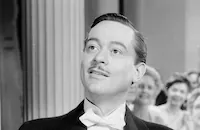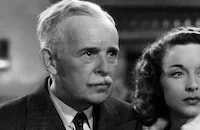Charlie Chan at the Olympics
Brief Synopsis
Cast & Crew
H. Bruce Humberstone
Warner Oland
Katherine De Mille
Pauline Moore
Allan Lane
Keye Luke
Film Details
Technical Specs

Synopsis
After a pilot testing a device by which his plane is guided by remote control is hijacked, Charlie Chan of the Honolulu police comes on the case. Chan finds the plane with the device, which could be sold for millions to a foreign power, gone and the pilot dead. Later, he also locates the body of the murderer, Miller. Chan, Hopkins, the airplane owner, and Cartwright, the inventor of the device, take the dirigible Hindenburg to Berlin to investigate three people traveling there by ocean liner: Dick Masters, an Olympic pole-vaulter and aviator, who did not pilot the plane the day of its disappearance because of an injured shoulder; Yvonne Roland, who visited Miller's room; and Arthur Hughes, an arms dealer, who wanted to buy the device. In Berlin, Chan finds the device hidden in a box in the luggage of Masters' girl friend Betty Adams. He substitutes a book and returns the box to Hopkins. Cartwright tells Chan that Hughes accused Hopkins of double-crossing him and threatened to expose Hopkins' plan to sell the device to a foreign government, and that Hopkins escaped with the box. Masters is now suspected because the box was found in Betty's room and the fact that he was on the boat with Roland. Roland, however, takes the box to a foreign diplomat, the Honorable Charles Zaraka, who discovers the book instead of the device. After Hughes learns of this, Chan's son Lee, an Olympic swimmer, is kidnapped. Following instructions sent from the kidnapper, Chan brings the device, which he has had removed and replaced with a transmitter, to an agreed upon location. He is then taken to Zaraka's estate, where Hopkins identifies the device. Hughes arrives with his thugs and fights Zaraka's henchmen for the device before he discovers that it is a phony. After the police arrive and Hopkins is shot, Chan reveals that Cartwright shot him, and that earlier Cartwright murdered Miller and made it appear that Hopkins stole the device. Hopkins recovers and Lee wins the hundred meter race.

Director

H. Bruce Humberstone
Cast

Warner Oland
Katherine De Mille
Pauline Moore
Allan Lane

Keye Luke

C. Henry Gordon

John Eldredge
Layne Tom Jr.

Jonathan Hale
Morgan Wallace
Fredrik Vogeding
Andrew Tombes

Howard Hickman
Selmer Jackson

Edward Keane
Arno Frey
Caroline "spike" Rankin
O. G. "dutch" Hendrian
Billy Wayne

Emmett Vogan
George Chandler
Al Kikume
William Von Brincken
Brooks Benedict
Ferdinand Schumann-heink
Hans Fuerberg
John Peters
Minerva Urecal
Constant Franke

Paul Panzer
Virgil B. Nover
Perry E. Seeley
Tom Klune
Ben Hendricks
Don Brody
Philip Morris
Lee Shumway
Stanley Blystone
Glen Cavender
Walter Bonn
David Horsley
Frank Bruno
Theresa Harris
Tony Merlo
Louis Natheaux
Bill Beggs
Crew
Fred Allen
Jasper Blystone
Paul Burger
Daniel B. Clark
Robert Ellis
Chester Gore
Herschel
Albert Hogsett
Samuel Kaylin
Harry M. Leonard
Helen Logan
John Stone
E. Clayton Ward

Film Details
Technical Specs

Quotes
Trivia
Stock footage of the dirigible Hindenburg was retouched, frame by frame, to blot out the swastikas emblazoned on the airship's tail.
Notes
This film contained newsreel footage of the dirigible Hindenburg, which exploded before the release of the film, and events in the Olympic Games of 1936, including a relay race showing American runner Jesse Owens. This film introduced Layne Tom, Jr. as Charlie Chan's youngest son. John Carradine is listed as a cast member in Hollywood Reporter production charts, but his participation in the final film has not been confirmed. For information concerning the series, please consult the Series Index and see the entry below for Charlie Chan Carries On.

Miscellaneous Notes
Released in United States 1937
Released in United States July 1984
Released in United States 1937
Released in United States July 1984 (Shown at FILMEX: Los Angeles International Film Exposition (50 Hour Sports Movie Marathon) July 5¿20, 1984.)











